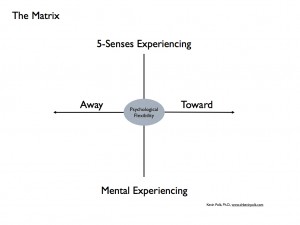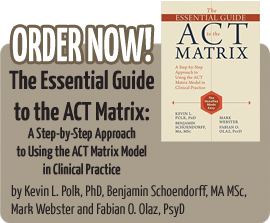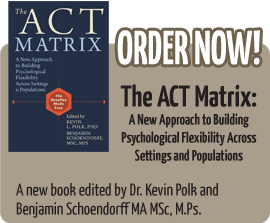The Matrix Plus Ostrom’s 8 and “The Spoke Diagram”
Don’t forget to sign up to the Newsletter to get your free Psychological Flexibility Guide. Look to the upper right.
Workgroups are usually started with “Two Loops” around the matrix diagram (below). That’s easy; the first loop is about each individual’s matrix. The second loop is about the group’s shared matrix, e.g., What the workgroup is about moving toward (lower right matrix), the stuff that shows up in the group and gets in the way like fear, anger, egos and such (lower left), the workgroup behaviors done to move away (upper left), and the behaviors the group can do to move toward (upper right). Once the two loops are completed, it’s time for “The Spoke Diagram.”
While playing around with ProSocial (David Sloan Wilson, Steve Hayes, and others) I came up with the “Spoke” diagram for easily measuring a workgroup’s functioning on Elinor Ostrom’s 8 design features for successful workgroups.
I had the two lines of the Matrix (vertical and horizontal lines), which gave me four points. The labels did not match, but I could see that in terms of “points” I was half way to 8. So I added another matrix shifted 45 degrees resulting in 8 points. Once I did that, it formed a familiar wagon-wheel pattern. From there it was not much of a leap for my mind envisioning each spoke as being measured from zero (0) at the hub of the wheel to ten (10) at the rim.
It’s a fairly straightforward process to training a workgroup in each of Ostrom’s 8 to the point that they can measure themselves on each of the “spokes.” The amount of training is variable, but almost all workgroups can quickly be educated to the point they can make a good guess about functioning on each spoke. Such training might take just a few minutes, might take a day or two with some groups.
Workgroups who rate themselves as functioning at a “10” on each of Ostrom’s 8 would be “Rolling Along” on a smooth ride. Groups that measured themselves with less than “10” on some features would be having a “Bumpy” ride.
Note: One of my students told me about extending the metaphor to a workgroup having all zeros (0s). Such a group would be spinning on the axle and going no where.
I do the occasional “ProSocial” webinar about doing the Two Loops and the Spoke. I also do in-person training. Let me know if your workgroup or organization would like to learn more.
Kevin
www.drkevinpolk.com







